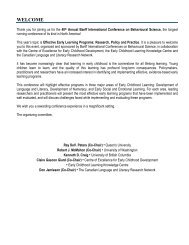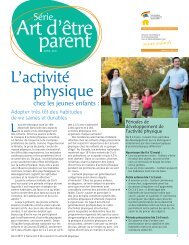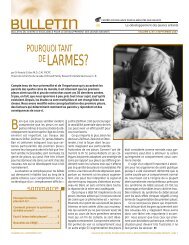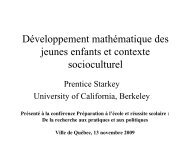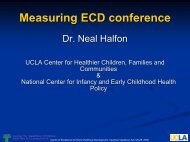Right from the start - Centre of Excellence for Early Childhood ...
Right from the start - Centre of Excellence for Early Childhood ...
Right from the start - Centre of Excellence for Early Childhood ...
You also want an ePaper? Increase the reach of your titles
YUMPU automatically turns print PDFs into web optimized ePapers that Google loves.
“<strong>Right</strong> <strong>from</strong> <strong>the</strong> Start” and<br />
O<strong>the</strong>r Attachment Interventions<br />
Alison Niccols, Ph.D.<br />
McMaster University & Hamilton Health Sciences<br />
Phone 905-521-2100 ext. 77408, fax 905-521-7926, email niccols@hhsc.ca<br />
• Attachment Theory<br />
• Attachment Research:<br />
Characterizing variations<br />
Developmental & neurological implications<br />
• Evidence-based Interventions<br />
• <strong>Right</strong> <strong>from</strong> <strong>the</strong> Start<br />
• Questions/Comments/Discussion<br />
<strong>Centre</strong> <strong>of</strong> <strong>Excellence</strong> <strong>for</strong> <strong>Early</strong> <strong>Childhood</strong> Development 1
A Bit <strong>of</strong> History<br />
• 1915 - children raised in institutions<br />
• Skeel - effects on mental and social<br />
functioning, cause vs effect<br />
• Rene Spitz - movies<br />
• WWII orphans<br />
WHO commissioned Bowlby,<br />
“Maternal Care & Mental Health”<br />
• Attachment <strong>the</strong>ory<br />
“Attachment & Loss” 1969-1980<br />
<strong>Centre</strong> <strong>of</strong> <strong>Excellence</strong> <strong>for</strong> <strong>Early</strong> <strong>Childhood</strong> Development 2
What is Attachment<br />
an affectional bond or tie between and infant and<br />
his/her mo<strong>the</strong>r figure<br />
Bowlby’s Attachment Theory<br />
• proximity-maintaining behaviours<br />
• <strong>for</strong> protection<br />
• in balance with exploration system<br />
• “secure base”<br />
What is NOT Attachment<br />
O<strong>the</strong>r parental roles:<br />
teacher, playmate, physical caregiver<br />
<strong>Centre</strong> <strong>of</strong> <strong>Excellence</strong> <strong>for</strong> <strong>Early</strong> <strong>Childhood</strong> Development 3
Ainsworth’s<br />
Strange Situation<br />
• infant & mo<strong>the</strong>r<br />
Procedure<br />
• (stranger enters) infant, mo<strong>the</strong>r, & stranger<br />
• (mo<strong>the</strong>r leaves) infant & stranger<br />
• (mo<strong>the</strong>r returns, stranger leaves)infant & mo<strong>the</strong>r<br />
(FIRST REUNION)<br />
• (mo<strong>the</strong>r leaves) infant alone<br />
• (stranger returns) infant & stranger<br />
• (mo<strong>the</strong>r returns) infant & mo<strong>the</strong>r (SECOND<br />
REUNION)<br />
<strong>Centre</strong> <strong>of</strong> <strong>Excellence</strong> <strong>for</strong> <strong>Early</strong> <strong>Childhood</strong> Development 4
<strong>Centre</strong> <strong>of</strong> <strong>Excellence</strong> <strong>for</strong> <strong>Early</strong> <strong>Childhood</strong> Development 5
Attachment Classifications<br />
B (Secure)<br />
-settles easily with mo<strong>the</strong>r upon reunion<br />
-history <strong>of</strong> consistently responsive caregiving<br />
A (Insecure - Avoidant)<br />
-ignores or avoids mo<strong>the</strong>r upon reunion<br />
-history <strong>of</strong> predictably unavailable or unresponsive caregiving<br />
C (Insecure - Resistant)<br />
-difficulty settling upon reunion<br />
-history <strong>of</strong> inconsistent, unpredictable caregiving<br />
D (Insecure - Disorganized)<br />
-odd behaviour, confusion, fear upon reunion<br />
-history <strong>of</strong> abuse/neglect<br />
<strong>Centre</strong> <strong>of</strong> <strong>Excellence</strong> <strong>for</strong> <strong>Early</strong> <strong>Childhood</strong> Development 6
Developmental Implications <strong>of</strong><br />
Insecure Attachment<br />
social withdrawal<br />
aggression towards peers<br />
parent-child conflict<br />
behaviour problems<br />
persistence with challenging tasks<br />
cognitive problem-solving competence<br />
mental health<br />
physical health<br />
<strong>Centre</strong> <strong>of</strong> <strong>Excellence</strong> <strong>for</strong> <strong>Early</strong> <strong>Childhood</strong> Development 7
Research on <strong>Early</strong> Brain<br />
Development<br />
• Stress reactions<br />
• Animals<br />
• Humans<br />
• Traumatized infants<br />
<strong>Centre</strong> <strong>of</strong> <strong>Excellence</strong> <strong>for</strong> <strong>Early</strong> <strong>Childhood</strong> Development 8
Secure attachment buffers cortisol reactivity, in general.<br />
high<br />
insecure<br />
Cortisol<br />
secure<br />
low<br />
T1<br />
T2 (scary toy)<br />
time<br />
<strong>Centre</strong> <strong>of</strong> <strong>Excellence</strong> <strong>for</strong> <strong>Early</strong> <strong>Childhood</strong> Development 9
Rethinking <strong>the</strong> Brain (Shore, 1997)<br />
Old Thinking/New Thinking:<br />
How a brain develops depends on <strong>the</strong> genes you were born with.<br />
How a brain develops depends on a complex interplay between <strong>the</strong> genes you<br />
were born with and <strong>the</strong> experiences you have.<br />
The experiences you have be<strong>for</strong>e age 3 have a limited impact on later<br />
development.<br />
<strong>Early</strong> experiences have a big impact on <strong>the</strong> structure <strong>of</strong> <strong>the</strong> brain, and on adult<br />
capacities.<br />
A secure relationship with a primary caregiver helps early development and<br />
learning.<br />
<strong>Early</strong> interactions don’t just help, <strong>the</strong>y directly affect <strong>the</strong> way <strong>the</strong> brain is<br />
“wired”.<br />
The brain’s capacity to learn and change grows steadily as an infant<br />
progresses toward adulthood.<br />
There are prime times <strong>for</strong> acquiring different kinds <strong>of</strong> knowledge and skills.<br />
A toddler’s brain is much less active than <strong>the</strong> brain <strong>of</strong> a college student.<br />
By <strong>the</strong> time a child is 3, <strong>the</strong>ir brain is twice as active as an adult. Brain activity<br />
levels drop during adolescence.<br />
<strong>Centre</strong> <strong>of</strong> <strong>Excellence</strong> <strong>for</strong> <strong>Early</strong> <strong>Childhood</strong> Development 10
Mismatch in Spending<br />
0 25 75<br />
Age<br />
• Most <strong>of</strong> SOCIAL SPENDING misses <strong>the</strong> years <strong>of</strong><br />
greatest brain malleability<br />
• The brain’s MALLEABILITY decreases with age<br />
<strong>Centre</strong> <strong>of</strong> <strong>Excellence</strong> <strong>for</strong> <strong>Early</strong> <strong>Childhood</strong> Development 11
What Influences Attachment<br />
Mo<strong>the</strong>r<br />
• responsiveness<br />
• her own childhood experiences<br />
• personality<br />
• depression<br />
• stress - parenting, life events<br />
• marital satisfaction, social support<br />
Infant<br />
• unique characteristics<br />
• reactivity to environment and people<br />
• special needs (e.g., premature, delayed)<br />
<strong>Centre</strong> <strong>of</strong> <strong>Excellence</strong> <strong>for</strong> <strong>Early</strong> <strong>Childhood</strong> Development 12
Video<br />
A Simple Gift: Com<strong>for</strong>ting<br />
Your Baby<br />
<strong>Centre</strong> <strong>of</strong> <strong>Excellence</strong> <strong>for</strong> <strong>Early</strong> <strong>Childhood</strong> Development 13
Attachment Interventions<br />
• Mo<strong>the</strong>r-child psycho<strong>the</strong>rapy<br />
(e.g., Fraiberg, Erickson, Lieberman)<br />
• Supportive home visiting<br />
(e.g., Barnard, Beckwith, Jacobson, Lyons-Ruth,<br />
Van den Boom)<br />
• Brief parent education<br />
(e.g., Anisfeld, Juffer, Meij, Lambermon)<br />
<strong>Centre</strong> <strong>of</strong> <strong>Excellence</strong> <strong>for</strong> <strong>Early</strong> <strong>Childhood</strong> Development 14
Issues in Evaluating<br />
Attachment Interventions<br />
Who At-risk (prevention) vs. identified (treatment)<br />
What Behavioural vs. representational intervention<br />
Goals Attachment vs attachment+<br />
What assessed Sensitivity, attachment, both<br />
<strong>Centre</strong> <strong>of</strong> <strong>Excellence</strong> <strong>for</strong> <strong>Early</strong> <strong>Childhood</strong> Development 15
A Model <strong>of</strong> Attachment<br />
Interventions<br />
infantparental<br />
mental<br />
representation<br />
<strong>of</strong> attachment<br />
parental<br />
sensitivity<br />
parent<br />
attachment<br />
intervention<br />
Van IJzendoorn et al. (1995)<br />
<strong>Centre</strong> <strong>of</strong> <strong>Excellence</strong> <strong>for</strong> <strong>Early</strong> <strong>Childhood</strong> Development 16
Evidence-based<br />
Attachment Interventions 1995<br />
• Meta-analysis by Van IJzendoorn et al., 1995<br />
• 12 studies assessing both sensitivity & attachment<br />
(N = 869)<br />
• Interventions more effective in improving sensitivity<br />
(d = .58) than attachment (d = .17)<br />
• Brief behavioural interventions more effective in<br />
improving attachment (d = .48) than long-term<br />
representational interventions (d = .00)<br />
• Unknown if <strong>the</strong> effects <strong>of</strong> brief behavioural interventions<br />
are temporary or long term<br />
<strong>Centre</strong> <strong>of</strong> <strong>Excellence</strong> <strong>for</strong> <strong>Early</strong> <strong>Childhood</strong> Development 17
Evidence-based<br />
Attachment Interventions 2003<br />
• Meta-analysis by Bakermans-Kranenburg, van<br />
Ijzendoorn, & Juffer (in press, Psych. Bull., & WAIMH,<br />
2002)<br />
• 81 studies (N = 7636)<br />
• Interventions more effective in improving sensitivity<br />
(d = .44) than attachment (d = small but significant)<br />
• Only behavioural interventions (targeting sensitivity)<br />
impacted on attachment, not supportive or<br />
representational interventions<br />
• Interventions <strong>start</strong>ing > 6 mo. better than prenatal<br />
or < 6 mo.<br />
• Brief (< 5 sessions) and moderate (5-16 sessions)<br />
better than longer (>16 sessions) interventions<br />
<strong>Centre</strong> <strong>of</strong> <strong>Excellence</strong> <strong>for</strong> <strong>Early</strong> <strong>Childhood</strong> Development 18
Promising Attachment<br />
Interventions<br />
• Hybrids:<br />
supportive home visits/behavioural/play-based<br />
(e.g., Watch, Wait, & Wonder; Krupka, McDonough<br />
Interaction Guidance, Benoit Modified Interaction Guidance,<br />
etc.)<br />
• Parent education in groups:<br />
<strong>Right</strong> <strong>from</strong> <strong>the</strong> Start<br />
<strong>Centre</strong> <strong>of</strong> <strong>Excellence</strong> <strong>for</strong> <strong>Early</strong> <strong>Childhood</strong> Development 19
Effect Sizes*<br />
Sensitivity Attachment<br />
Niccols (2003) RCT<br />
<strong>Right</strong> <strong>from</strong> <strong>the</strong> Start small large<br />
Home Visiting small 0<br />
(Nothing/Non-Attend) (--large) (--small)<br />
Bakermans-Kranenburg et al. (2003) medium<br />
small<br />
Van IJzendoorn et al. (1995) medium small<br />
-Brief behavioural<br />
medium<br />
-Long, representational 0<br />
*Cohen (1988) d’s small=0.20, medium=0.50, large=0.80<br />
<strong>Centre</strong> <strong>of</strong> <strong>Excellence</strong> <strong>for</strong> <strong>Early</strong> <strong>Childhood</strong> Development 20
<strong>Right</strong> <strong>from</strong> <strong>the</strong> Start:<br />
An 8-session Attachment Course <strong>for</strong> Parents <strong>of</strong> Infants under 2<br />
Alison Niccols, Ph.D.<br />
Infant-Parent Program<br />
Hamilton Health Sciences & McMaster University<br />
Features <strong>of</strong> “<strong>Right</strong> <strong>from</strong> <strong>the</strong> Start”<br />
Why Parent-Child Interaction<br />
Why Groups<br />
RFTS Content<br />
Who Attends<br />
RFTS Evaluation<br />
<strong>Centre</strong> <strong>of</strong> <strong>Excellence</strong> <strong>for</strong> <strong>Early</strong> <strong>Childhood</strong> Development 21
<strong>Right</strong> <strong>from</strong> <strong>the</strong> Start:<br />
An Attachment Course <strong>for</strong> Parents <strong>of</strong> Infants under 2<br />
Features<br />
• Free, open to any parent<br />
• Focus on parent-child interaction skills<br />
• Active learning model<br />
-video segments <strong>of</strong> common parenting challenges<br />
-small group problem solving<br />
-large group discussion<br />
-homework to practice skills<br />
• Various community locations & collaboration<br />
• 3-5x/Year (a.m./p.m.)<br />
• Free parking<br />
• Bus tickets<br />
• Free onsite <strong>Centre</strong> childcare<br />
<strong>of</strong> <strong>Excellence</strong> <strong>for</strong> <strong>Early</strong> <strong>Childhood</strong> Development 22
Frequently Asked Questions<br />
Who should attend<br />
Any parent <strong>of</strong> an infant under 2 years at-risk <strong>for</strong> problems in social,<br />
emotional, physical, and/or cognitive development.<br />
Who should not attend<br />
Those who are not actively parenting or caring <strong>for</strong> an infant (i.e.,<br />
those who do not have custody and/or only very limited visitation;<br />
expectant parents).<br />
How do parents access <strong>the</strong> group<br />
Parents must register <strong>the</strong>mselves (and <strong>the</strong>ir children <strong>for</strong> childcare,<br />
if needed) by calling <strong>the</strong> contact number.<br />
What is NOT addressed<br />
Basic parenting skills (e.g., child safety & nutrition), parenting<br />
capacity assessment.<br />
<strong>Centre</strong> <strong>of</strong> <strong>Excellence</strong> <strong>for</strong> <strong>Early</strong> <strong>Childhood</strong> Development 23
Why Parent-Child Interaction<br />
(Attachment Theory & Research)<br />
• Secure attachment has implications <strong>for</strong> social, emotional, and<br />
cognitive development<br />
• Sensitive, responsive parenting is associated with secure<br />
attachment<br />
• Some infants and parents are at risk <strong>for</strong> insecure attachment:<br />
infants who are fussy or have developmental or medical needs,<br />
parents who experienced poor parenting <strong>the</strong>mselves, are anxious,<br />
depressed, or have o<strong>the</strong>r limitations<br />
• Interventions that target parental sensitivity may improve <strong>the</strong><br />
attachment relationship, which may have implications <strong>for</strong> future<br />
development<br />
<strong>Centre</strong> <strong>of</strong> <strong>Excellence</strong> <strong>for</strong> <strong>Early</strong> <strong>Childhood</strong> Development 24
Why Parent Groups<br />
(Group Theory & Research)<br />
• Normalizing (i.e., less stigma than individual intervention)<br />
• Social/peer support<br />
• Parent modeling<br />
• Group self-regulation<br />
• Parent control/readiness <strong>for</strong> change<br />
• Potential <strong>for</strong> primary and secondary prevention (i.e.,<br />
population-based community service)<br />
• Cost saving<br />
<strong>Centre</strong> <strong>of</strong> <strong>Excellence</strong> <strong>for</strong> <strong>Early</strong> <strong>Childhood</strong> Development 25
Video<br />
Session 2 Clip 1<br />
<strong>Centre</strong> <strong>of</strong> <strong>Excellence</strong> <strong>for</strong> <strong>Early</strong> <strong>Childhood</strong> Development 26
The Coping Modeling<br />
Problem-solving Model<br />
• Active adult learning - what is it<br />
• Why use it - Benefits<br />
• Resistance vs. empowerment<br />
• Role <strong>of</strong> <strong>the</strong> Leader (facilitation)<br />
<strong>Centre</strong> <strong>of</strong> <strong>Excellence</strong> <strong>for</strong> <strong>Early</strong> <strong>Childhood</strong> Development 27
<strong>Right</strong> <strong>from</strong> <strong>the</strong> Start<br />
Goals<br />
• To help parents facilitate <strong>the</strong>ir infant’s<br />
development through sensitive, responsive<br />
parent-child interactions<br />
• To help parents develop confidence in parenting<br />
<strong>the</strong>ir infant<br />
• To educate parents about emotional, social, and<br />
communication development in infants<br />
• To provide parents with support and networking<br />
opportunities with o<strong>the</strong>r parents<br />
<strong>Centre</strong> <strong>of</strong> <strong>Excellence</strong> <strong>for</strong> <strong>Early</strong> <strong>Childhood</strong> Development 28
<strong>Right</strong> <strong>from</strong> <strong>the</strong> Start<br />
Content<br />
1. Attachment Security:<br />
“What is it and why is it important”<br />
2. Parent-Child Interaction:<br />
“How do you show me you love me”<br />
3. Child and Parent Personality:<br />
“I am unique and so are you”<br />
4. Disengage Cues:<br />
“I don’t like what you’re doing right now”<br />
5. Engage/Approach Cues:<br />
“I like what you’re doing right now” / “I need you”<br />
6. Following Your Child’s Lead:<br />
“This is what I’m interested in right now”<br />
7. Building a Healthy Relationship:<br />
“I like being with you”<br />
8. Wrap Up<br />
<strong>Centre</strong> <strong>of</strong> <strong>Excellence</strong> <strong>for</strong> <strong>Early</strong> <strong>Childhood</strong> Development 29
A very mixed group <strong>of</strong> parents in terms <strong>of</strong> age, SES/cultural<br />
status, and psychiatric and cognitive functioning.<br />
Group size & attrition<br />
Who Usually Attends<br />
Specific Families<br />
Examples <strong>of</strong> families who have attended in <strong>the</strong> past<br />
- illiterate fa<strong>the</strong>r with sole custody <strong>of</strong> “fussy” daughter<br />
- what parents say <strong>the</strong>y like<br />
- parents <strong>of</strong> premature infant (ONtv spot)<br />
<strong>Centre</strong> <strong>of</strong> <strong>Excellence</strong> <strong>for</strong> <strong>Early</strong> <strong>Childhood</strong> Development 30
Videos<br />
ONtv Health Spot<br />
Interview with Sunni<br />
<strong>Centre</strong> <strong>of</strong> <strong>Excellence</strong> <strong>for</strong> <strong>Early</strong> <strong>Childhood</strong> Development 31
Pilot Study Results<br />
Niccols & Mohamed, Journal <strong>of</strong> <strong>Early</strong> intervention, 2000, 23, 133-143<br />
• RFTS is viewed by clients as highly effective<br />
and valuable<br />
• RFTS may be effective in:<br />
dysfunctional parent-child interaction<br />
parenting distress<br />
sadness/depression<br />
• Less intense follow-up services are requested<br />
<strong>Centre</strong> <strong>of</strong> <strong>Excellence</strong> <strong>for</strong> <strong>Early</strong> <strong>Childhood</strong> Development 32
Is RFTS really effective<br />
Isn’t individual in-home<br />
intervention better<br />
Research Questions &<br />
Current/Future Directions<br />
• fur<strong>the</strong>r study:<br />
a) factors affecting attendance<br />
b) objective measures <strong>of</strong> impact on parent & child<br />
& interaction<br />
c) compare to home visiting<br />
-media attention, training leaders in o<strong>the</strong>r communities<br />
<strong>Centre</strong> <strong>of</strong> <strong>Excellence</strong> <strong>for</strong> <strong>Early</strong> <strong>Childhood</strong> Development 33
Randomized Clinical Trial<br />
(RCT)<br />
Registrants <strong>for</strong> “<strong>Right</strong> <strong>from</strong> <strong>the</strong> Start”<br />
<br />
Study Participants<br />
<br />
Random Assignment<br />
<br />
8-session RFTS 8 sessions HV<br />
<strong>Centre</strong> <strong>of</strong> <strong>Excellence</strong> <strong>for</strong> <strong>Early</strong> <strong>Childhood</strong> Development 34
RCT Interventions<br />
Group (“<strong>Right</strong> <strong>from</strong> <strong>the</strong> Start”):<br />
• 8-session parenting course<br />
• uses attachment <strong>the</strong>ory as a framework to<br />
improve parent-child interaction (reading and<br />
responding to babies’ cues)<br />
• incorporates active learning model and peer<br />
support<br />
Individual (Home Visiting):<br />
• 8 weekly in-home sessions<br />
• family-centred intervention<br />
• incorporates Barrera’s Transactional Model<br />
and Dunst’s Family Support Model<br />
<strong>Centre</strong> <strong>of</strong> <strong>Excellence</strong> <strong>for</strong> <strong>Early</strong> <strong>Childhood</strong> Development 35
Family Characteristics<br />
RFTS<br />
(n=11)<br />
HV<br />
(n=16)<br />
Non-<br />
Attend<br />
(n=7)<br />
Maternal age M yrs (SD) 29 (7) 30 (7) 26 (5)<br />
Education (high school) 91% 88% 63%<br />
SES (% low) 64% 44% 50%<br />
Single parent 27% 25% 38%<br />
Child age (M months) 8 11 8<br />
Infant attachment<br />
security (M AQS score)* low low low<br />
Child/family risks > 1 73% 75% 88%<br />
M # child/family risks 1.8 1.4 2.0<br />
<strong>Centre</strong> <strong>of</strong> <strong>Excellence</strong> <strong>for</strong> <strong>Early</strong> <strong>Childhood</strong> Development 36
RCT Measures<br />
(Pre-test, Post-test, and 6-month Follow-up)<br />
Observational Measures<br />
Infant Attachment Security:<br />
Attachment Q-sort (AQS; Waters & Deane, 1985)<br />
Maternal Sensitivity:<br />
Maternal Behaviour Q-sort (MBQS; Pederson et al., 1990)<br />
Home Environment:<br />
Home Observation <strong>for</strong> Msrmnt. <strong>of</strong> Env (HOME; Caldwell & Bradley, 1984)<br />
Standardized, Parent-report Measures<br />
Maternal Depression:<br />
<strong>Centre</strong> <strong>for</strong> Epidemiol’l Studies Dep. Scale (CESD; Devins & Orme, 1985)<br />
Parenting Stress, Perception <strong>of</strong> child as difficult, Dysfunctional interaction:<br />
Parenting Stress Index (PSI-SF; Abidin, 1990)<br />
Coping:<br />
Family Crisis Oriented Personal Scales (F-COPES; McCubbin, 1982)<br />
O<strong>the</strong>r Measures<br />
Demographic in<strong>for</strong>mation, participant characteristics, adherence & participation<br />
measures, intervention fidelity, Client Satisfaction Questionnaire (Niccols,<br />
1996), cost, follow-up service requests<br />
<strong>Centre</strong> <strong>of</strong> <strong>Excellence</strong> <strong>for</strong> <strong>Early</strong> <strong>Childhood</strong> Development 37
Client Satisfaction:<br />
Overall/General<br />
RFTS HV<br />
% %<br />
Quality – good/excellent 89 100<br />
Met most <strong>of</strong> your needs 78 92<br />
Would you recommend to o<strong>the</strong>rs 100 92<br />
Would you come back 89 92<br />
Satisfied with session number,<br />
frequency, duration, scheduling<br />
78-100 91-100<br />
<strong>Centre</strong> <strong>of</strong> <strong>Excellence</strong> <strong>for</strong> <strong>Early</strong> <strong>Childhood</strong> Development 38
Client Satisfaction:<br />
Perceived Effects <strong>of</strong> RFTS & HV<br />
RFTS<br />
%<br />
Agree<br />
HV<br />
%<br />
Agree<br />
Learned how to & interact better with<br />
baby 89-100 92<br />
Increased knowledge about early<br />
development, at-risk infants, & own baby 78-100 92-100<br />
Better at problem solving 78 100<br />
Learned how to interact with o<strong>the</strong>r<br />
children in family 100 86<br />
Increased knowledge <strong>of</strong> community<br />
resources 89 100<br />
More confident in reading baby’s cues &<br />
dealing with baby 78-89 82-92<br />
Made new friends 78 N/A<br />
Feel less stressed 88 100<br />
<strong>Centre</strong> <strong>of</strong> <strong>Excellence</strong> <strong>for</strong> <strong>Early</strong> <strong>Childhood</strong> Development 39
Pre- to 6-mo Follow-up<br />
Comparisons*<br />
*Results are similar <strong>for</strong> Pre-Post comparisons<br />
Parent-child dysfunctional<br />
interaction (PSI-PCDI)<br />
Parenting Stress<br />
(PSI-Total)<br />
Perceive child as difficult<br />
(PSI-DC)<br />
Coping<br />
(F-COPES Total)<br />
Maternal Depression<br />
(CESD)<br />
Home Environment<br />
(HOME Total)<br />
RFTS HV Non-Attend<br />
(n=11) (n=16) (n=7)<br />
<strong>Centre</strong> <strong>of</strong> <strong>Excellence</strong> <strong>for</strong> <strong>Early</strong> <strong>Childhood</strong> Development 40
Maternal Sensitivity & Infant Attachment<br />
Pre- to 6-mo Follow-up Comparisons*<br />
Sensitivity d n Attachment d n<br />
<strong>Right</strong> <strong>from</strong> <strong>the</strong> Start 0.1 13 0.7 5<br />
Home Visiting 0.3 16 0.0 9<br />
Non-Attenders -0.7 7 -0.2 4<br />
*Results are similar <strong>for</strong> Pre-Post comparisons<br />
<strong>Centre</strong> <strong>of</strong> <strong>Excellence</strong> <strong>for</strong> <strong>Early</strong> <strong>Childhood</strong> Development 41
Costs and<br />
Requests <strong>for</strong> Fur<strong>the</strong>r Service*<br />
RFTS<br />
M (SD)<br />
HV<br />
M (SD)<br />
Cost (per person per session) $53.19 (20.94) $87.10 (45.36)<br />
RFTS HV Non-Attend<br />
(n = 11) (n = 16) (n = 5)<br />
Request <strong>for</strong> fur<strong>the</strong>r service 9% 38% 80%<br />
*significant group differences, p
Results Summary<br />
• Infants <strong>of</strong> parents who registered <strong>for</strong> RFTS and<br />
volunteered <strong>for</strong> <strong>the</strong> study were at risk (i.e., parents<br />
self-identified/referred appropriately)<br />
• Both RFTS & HV were viewed by clients as highly<br />
effective and valuable<br />
• Nonattenders and parents who attended RFTS or<br />
had HV showed decreased levels <strong>of</strong> parent-child<br />
dysfunctional interaction and parenting stress<br />
<strong>Centre</strong> <strong>of</strong> <strong>Excellence</strong> <strong>for</strong> <strong>Early</strong> <strong>Childhood</strong> Development 43
Results Summary Cont’d<br />
• Parents who attended RFTS or had HV reported<br />
decreased levels <strong>of</strong> difficult child behaviour and<br />
improvements in coping<br />
• HV may be effective in decreasing maternal depression<br />
and improving maternal sensitivity and <strong>the</strong> home<br />
environment<br />
• RFTS may be effective in improving infant attachment<br />
security and costs significantly less than HV<br />
• Fewer parents request follow-up services after <strong>Right</strong><br />
<strong>from</strong> <strong>the</strong> Start than Home Visiting or non-attendance.<br />
<strong>Centre</strong> <strong>of</strong> <strong>Excellence</strong> <strong>for</strong> <strong>Early</strong> <strong>Childhood</strong> Development 44
Caveat<br />
SMALL SAMPLE SIZE!<br />
Questions<br />
What factors affect attendance<br />
What are <strong>the</strong> long term effects <strong>of</strong> RFTS<br />
What types <strong>of</strong> clients benefit most <strong>from</strong> RFTS<br />
What types <strong>of</strong> clients benefit most <strong>from</strong> HV<br />
How do we best integrate RFTS into an efficient,<br />
effective service delivery model in <strong>the</strong> early years<br />
<strong>Centre</strong> <strong>of</strong> <strong>Excellence</strong> <strong>for</strong> <strong>Early</strong> <strong>Childhood</strong> Development 45



